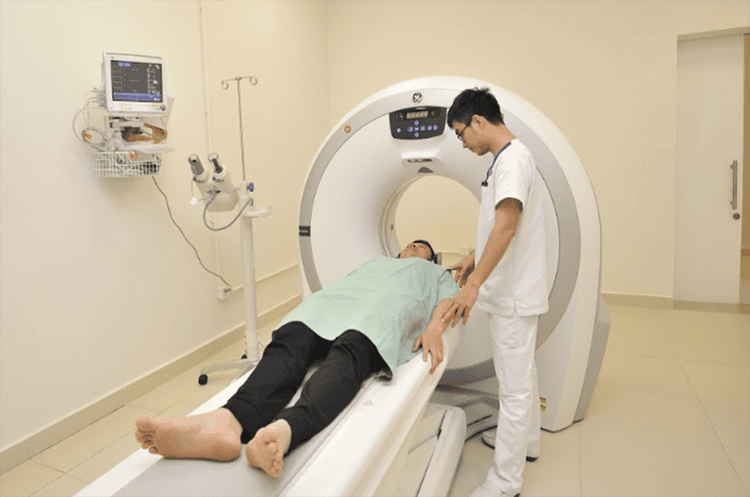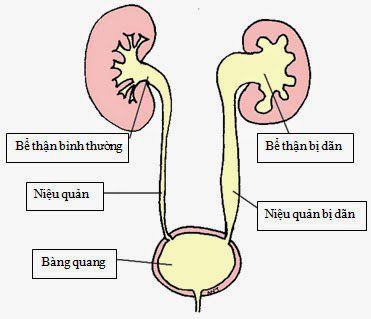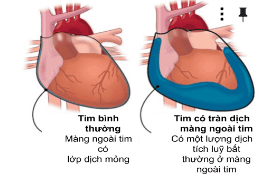This is an automatically translated article.
The article was written by Dr. Trinh Van Dong - Radiologist - Department of Radiology - Vinmec Ha Long International General Hospital.Hip pain is a typical symptom of ureteral stone disease and also a symptom of many other diseases. There are many diagnostic methods, but 64-slice tomography is considered the method that allows accurate diagnosis of ureteral stone disease.
1. Overview of ureteral stone disease
Ureteral stone disease is one of the common urinary tract diseases. The disease causes dull pain in the hips, lower back, kidney pain, blood in the urine, pus, ... Ureteral stones if not detected and treated early can cause dangerous complications such as pyelonephritis , urinary tract infections , acute renal failure and chronic renal failure .To diagnose the disease, there are currently many methods applied such as X-ray, intravenous drug nephrography (UIV), computed tomography (CT scan), ultrasound, .... However, For accurate diagnosis, 64-slice tomography is used because it allows to determine the structure, composition and characteristics of stones. From there, doctors will come up with a suitable and effective treatment method.

Sỏi niệu quản không được phát hiện sớm sẽ gây nhiều biến chứng nguy hiểm
2. Advantages of 64-slice tomography in diagnosing ureteral stones
64 slices tomography is considered the optimal method in diagnosing ureteral stones thanks to the following advantages:
Capture, survey and process images in isotropic, multifaceted, high resolution high, creating a flat forehead. Indicate the exact location, size, number of stones. Indicates whether there is fluid retention in the kidneys or ureters. Indicate the characteristics and density of the gravel structure, thereby determining the composition and fragility of the gravel.

Chụp cắt lớp 64 lát cắt mang lại nhiều ưu điểm trong chẩn đoán sỏi niệu quản
3. Signs of ureteral stones on 64-slice tomography
64-slice tomography without contrast allows the detection of most types of ureteral stones, including stones such as uric acid stones, cystin stones, and xanthine stones (which are non-contrast stones). Some rarer stones such as stones caused by the drug indinavir, protease inhibitors (used in the treatment of HIV), pure substrate stones are more difficult to detect.
The sign of ureteral stones on 64-slice computed tomography is a high-density shadow of the stone, surrounded by the ureteral wall with a soft-tissue density border. In addition, 64-slice computed tomography can also show complications of ureteral stones such as pyelonephritis, ureteral dilatation, edema of fatty tissues around the ureter or around the kidney, and enlarged stones. The early diagnosis and detection of ureteral stones, especially stones larger than 6mm, is of great significance in treatment because at this time, the possibility of stone drainage is very low.

Chụp cắt lớp 64 lát cắt còn giúp phát hiện biến chứng khác như giãn đài bể thận
4. How is the location and size and composition of the gravel determined?
64-slice tomography allows to determine the location, size and composition of the stone as follows:
Location and size: 64-slice tomography allows to determine the exact location and size of the stone. Thanks to that, it is possible to predict the success of the treatment of extracorporeal lithotripsy. Most stones are less than 4mm (90%) and about 50% of stones between 4mm-7mm can drain on their own. Stone composition: Stone density on 64-slice tomography images is the basis for determining the composition of stones. If the density is 200 - 450 HU - uric acid stones, 600 - 900 HU - struvite stones, 600 - 1600 HU - cysteine stones, 1700 - 2800 HU - calcium stones. Depending on the type of ureteral stone, there will be an appropriate treatment. However, because the composition of stones includes many different substances, it can make diagnosis difficult. The significance of 64-slice computed tomography in the diagnosis of ureteral stones is shown by the density of the stone shadow. From there, it is possible to determine the exact location, size, number, and composition of stones, as a basis for choosing an appropriate treatment method.
In order to improve the quality of medical examination, diagnosis and treatment, currently Vinmec International General Hospital has been and continues to invest in a system of modern machinery and medical equipment with various types of CT scanners. class, X-ray, magnetic resonance, ... in the diagnosis of urological diseases, including diagnostic procedures for ureteral stones. Especially with a team of good doctors, perfect medical services will bring the best treatment results for your health.
Master, Doctor Trinh Van Dong has nearly 10 years of experience in the specialty of Diagnostic Imaging, especially has strengths in performing techniques: X-ray, ultrasound, computed tomography, magnetic resonance. Currently, Dr. Dong is working and working at the Department of Diagnostic Imaging, Vinmec Ha Long International General Hospital.
You can directly go to Vinmec Health system nationwide to visit or contact the regional hospital hotline here for support.














